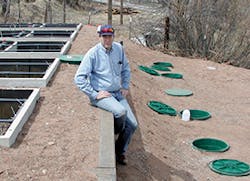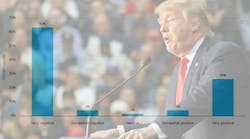Like for many of his peers, David Venhuizen, P.E., of Venhuizen Water Works in Austin, TX, the idea of using potable water for non-potable purposes doesn’t sit well. But for Venhuizen, neither does the use of “purple pipe,” which he sees as economically inefficient. “End-of-pipe perpetuates the conventional centralized wastewater system, routing all of the flow to that far-away treatment plant and returning the water back to close where it was generated,” he points out.
Venhuizen advocates for a decentralized concept in which a small treatment plant is installed during development with water treated as close to its use as possible and reused through such approaches as recirculating biofilters and constructed wetlands. Rainwater harvesting maximizes the effort. “Zero-net water” centers the water supply on rainwater harvesting for interior use, irrigation with reuse water, and low-impact development (LID) stormwater management to hold more water on the land, thus maintaining the area’s hydrologic integrity and increasing water use efficiency by “growing” the water supply in direct proportion to its demand. There are huge gains to be attained from a fundamental reorganization of resources infrastructure, some of which are climate-specific and would be helpful in places such as Texas and California where there is significant irrigation demand, says Venhuizen. He points to Portland, OR; and Philadelphia, PA, as places that have successfully implemented LID, and applauds South Alabama Utilities as a prime example of a large utility embracing decentralized management.
What He Does Day to Day
Venhuizen spends a great deal of time trying to get buy-in from the mainstream controlling institutions for the decentralized concept in his region. It’s an effort he’s been at for 30 years. Venhuizen also works on designing rainwater harvesting systems. At Texas State University, he ran a project investigating rainwater harvesting as the water supply for whole developments in contrast to “punching more holes in the ground to mine unsustainable aquifers or long transfers to bring the water in from remote areas, which is extremely expensive.” Venhuizen also designs onsite wastewater systems using treated water in subsurface drip irrigation for the highest value landscaping. Venhuizen, a licensed irrigator in Texas, also designs LID stormwater systems and a few “straight-up” irrigation systems.
What Led Him Into This Line of Work
Venhuizen earned B.S. degrees in aeronautical and astronautical engineering and biology from the University of Illinois, and an M.S. in civil engineering from the University of Texas, but dropped his childhood dream to become an astronaut when he realized his 6’5″ frame ruled him out as a candidate. He combined aeronautical engineering and biology with the idea of working on closed ecology water recycling systems, coming full circle to working in water recycling in an open system ecology.
In the 1970s, Venhuizen, a self-described “solar hippie,” heard a presentation championing water hyacinths wastewater treatment systems using greenhouses to cover ponds for freeze protection during winter. While working on a project to install two ponds for San Marcos, TX’s wastewater treatment plant, covering them with differently designed greenhouses, evaluating the water hyacinth treatment systems and doing wind power for aeration, Venhuizen saw close up how the city used conventional means to manage wastewater and concluded that “activated sludge is nuts.”
Yet, covering hyacinth treatment systems with greenhouses proved to be too costly. His solution: use a set of long, narrow parallel cells, making the greenhouse span easier to build. Then he thought if all of the cells were independent, it would distribute the treatment.
“That’s how I came up with the decentralized concept idea,” he says. Venhuizen further refined the idea after hearing talks about intermittent sand filters, effluent sewers, and rock reed filters.
What He Likes Most About His Job
Venhuizen says he enjoys the creative process entailed in figuring out how to solve water challenges in a “better” way while saving water and money.
His Biggest Challenge
Getting his message across and the work to do it on a meaningful scale is his greatest challenge, Venhuizen says. He’s hoping a few developers will “flip” their opinion and consider decentralization. “What we really need is to get that shining example on the ground, and then I think we’ll have a big breakthrough moment,” says Venhuizen.


